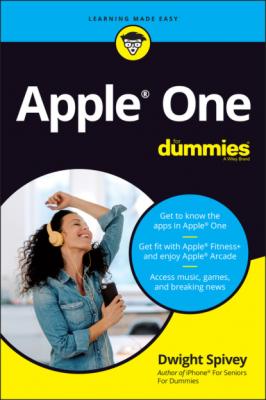Apple One For Dummies. Dwight Spivey
Чтение книги онлайн.
Читать онлайн книгу Apple One For Dummies - Dwight Spivey страница 7

Apple's move into the multimedia market — providing music, movies, magazines, games, and the like for their legions of users (that is, fans) — wasn’t exactly a surprise. But their enormous success has been. Let’s find out together just what Apple services are and what they provide.
What Are Apple Services?
Apple services are not religious gatherings designed to spread the good news of the Cupertino company’s wares, even though some Apple afficionados may appear to worship everything they do. In this case, these services are software platforms designed to deliver a particular set of goods to a customer.
Are you a music lover who wishes you could take all your music everywhere you go, but you don’t want to clog all your devices with gigabytes of songs? Would you like to take a photo on your iPhone and instantly share it with someone across the globe? Apple can provide these types of amenities to customers through their services.
Apple’s services include the following:
Apple Music
Apple TV+
Apple Arcade
Apple News+
Apple Fitness+
iCloud (finally, one that doesn’t start with Apple!)
Each of these services is designed to meet a customer’s needs in the simple and intuitive style Apple is known for. They’re also made to work seamlessly across the spectrum of Apple’s hardware devices, allowing you to move from device to device while barely skipping a beat. For example, you can watch a movie on the train after work, and then pick up right where you left off on your Apple TV the minute you walk into your apartment.
To a large extent, these services also work across non-Apple devices. Let’s say you’re at a friend’s house working on a spreadsheet in Numbers on your iPad, but its battery dies (and, of course, you left the charger at home). No worries: Just fire up the web browser on your friend’s PC, log in to iCloud.com, open Numbers from there, and get straight back to work — picking up exactly where you left off when your iPad decided to take a nap.
Now that’s not just service with a smile but services that cause a smile. :)
Apple Services in a Nutshell
In this section, I introduce you to each of the aforementioned services. Getting the proverbial ten-thousand-foot view will help you get a quick idea of what each brings to the table. If you’re eager to read about a particular service, feel free to flip to the chapter or chapters dedicated to it.
Apple Music
Luckily, Apple doesn’t make you do much guesswork when it comes to knowing the main thrust of a service — simply read its name. Apple Music does exactly what you think it does; broadly speaking, it grants you access to music. And not just some music and not just a few select tracks. Instead you have access to lots and lots of music — to the tune (pun intended) of more than 70 million songs and counting.
Apple Music launched in 2015 and quickly gained a little over 6 million subscribers. By June 2020 those numbers were just over 70 million. Apple must be doing something right, yes?
Apple Music, shown in Figure 1-1, allows you to sync all your music across your devices even non-Apple ones, such as an Android smartphone or tablet. You can even sign into your Apple Music account in iTunes for Windows.
https://music.apple.com, and sign in to enjoy.
You can also create playlists of your favorite songs, and even listen to those curated for you by Apple based on your listening habits. Take a gander at Chapter 3 to learn all about Apple Music.
Photo courtesy of Apple, Inc.
FIGURE 1-1: Apple Music works on just about any Internet-connected device.
Apple TV+
Apple TV+ is a video streaming service that’s Apple’s answer to Netflix, Hulu, Amazon Prime, and the like.
Apple TV+ is relatively new to the streaming game, having been around only since the latter part of 2019. Its programming isn’t as extensive as some of its toughest competitors, and consequently its user base isn’t as large (around 10 million subscribers but growing).
Original programming for Apple TV+ has been outstanding, with such names as Steven Spielberg, Oprah Winfrey, and Tom Hanks (check him out in Figure 1-2) attached to the service. Apple has also been adding quality third-party content of late. One huge example of this type of programming expansion (at least in my household) is that the home of the beloved Charlie Brown specials, A Charlie Brown Thanksgiving and A Charlie Brown Christmas, is now Apple TV+, not one of the “big three” networks.
Chapter 4 discusses all things Apple TV+, including how to use it with your Apple TV streaming box.
Photo courtesy of Apple, Inc.
FIGURE 1-2: Apple TV+ provides great original programming.
Apple Arcade
For years, iPhone and iPad have been great gaming devices, but no one would mistake either of them for an Xbox or a PlayStation. Games on an iPhone or iPad are fun to play and there’s been a huge selection of them for quite a while. Some of the biggest games of recent years may even owe Apple a debt of gratitude for the reach into the world’s households they’ve enjoyed; Minecraft, Angry Birds, and Fortnite leap readily to mind.
Then Apple had the wonderful notion that it would be fantastic if we could carry over gameplay from one device to another in the Apple ecosystem. You know, play your game in the car (as a passenger, of course!), and then pick up right where you left off on your Apple TV. Figure 1-3 illustrates